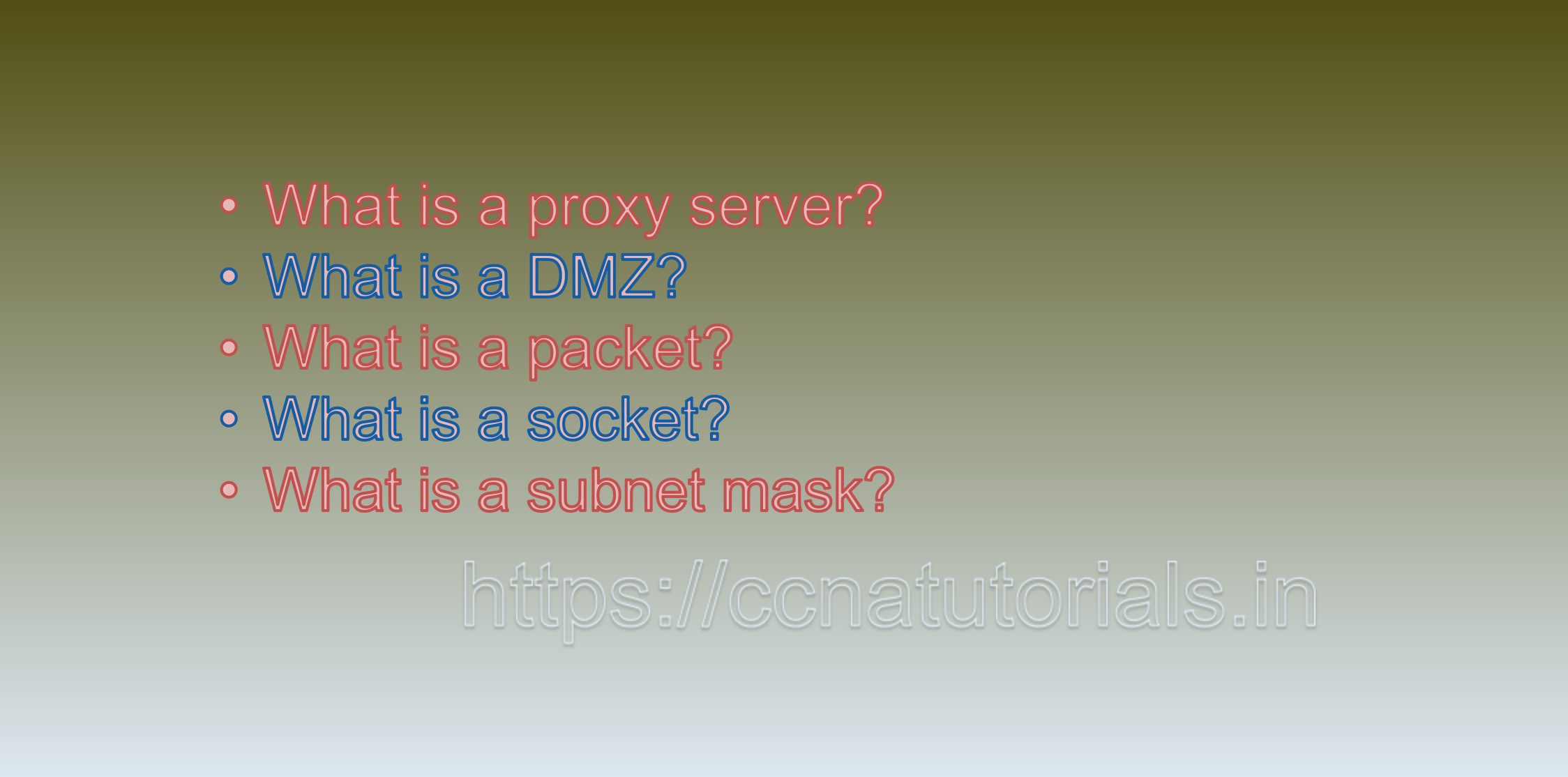Contents of this article
In this article, I describe some CCNA sample questions for practice before appearing in the CCNA 200-301 exam. The following questions are basic questions and related to the CCNA sample questions set 14. There are multiple sample questions set on this website for prior practice online. All questions are described with relevant answers. You can take the following questions and answer as reference for CCNA 200-301 exam. You may also need to do more practice with other websites and books to practice the CCNA sample questions set 14.
Question 1. What is a proxy server?
A proxy server is an intermediary server that sits between a client device, such as a computer or smartphone, and a destination server, such as a website or online service. When a client device requests access to a destination server, the request is first sent to the proxy server, which then forwards the request to the destination server on behalf of the client device.
The primary purpose of a proxy server is to provide security, privacy, and performance benefits for network traffic. Here are some of the key functions of a proxy server:
- 1. Security: A proxy server can be used to filter out malicious traffic, block unwanted websites, and protect against network-based attacks, such as distributed denial of service (DDoS) attacks.
- 2. Privacy: A proxy server can be used to anonymize network traffic, by masking the IP address of the client device and hiding its identity from the destination server. This can help protect the privacy and security of users on the network.
- 3. Performance: A proxy server can cache frequently accessed content, such as web pages, images, and videos, to speed up access and reduce bandwidth usage. This can help improve network performance and reduce costs.
- 4. Access control: A proxy server can be used to restrict access to certain websites or online services, based on user identity, time of day, or other criteria. This can help organizations enforce network policies and prevent unauthorized access.
Proxy servers can be deployed on-premises, as a physical or virtual server, or in the cloud, as a cloud-based service. There are also different types of proxy servers, including HTTP proxies, SOCKS proxies, and SSL proxies, each with their own specific functions and features.
A proxy server is an intermediary server that sits between a client device and a destination server and can be used to provide security, privacy, performance, and access control benefits for network traffic.This is the answer to question 1 of CCNA sample questions set 14.
Question 2. What is a DMZ?
A DMZ, short for Demilitarized Zone, is a separate and isolated network segment that sits between a company’s internal network and the internet. The purpose of a DMZ is to provide an additional layer of security by creating a buffer zone that separates the public-facing systems, such as web servers and email servers, from the rest of the internal network.
In a DMZ, the public-facing systems are exposed to the internet and can receive incoming traffic, while the internal network remains protected behind a firewall. This provides an additional layer of security, as any potential attacks or breaches against the public-facing systems will be contained within the DMZ and will not be able to access the internal network.
A DMZ can be set up using a variety of network security technologies, such as firewalls, routers, and intrusion prevention systems (IPS). The configuration of a DMZ will depend on the specific security requirements of the organization, but typically involves placing public-facing systems in a separate network segment that is isolated from the internal network and is accessible only through a limited set of network ports and protocols.
In summary, a DMZ is a separate and isolated network segment that sits between a company’s internal network and the internet and is designed to provide an additional layer of security by separating the public-facing systems from the internal network. A DMZ is an important security measure for organizations that need to provide external access to their systems, such as web servers and email servers, while maintaining a secure internal network. This is the answer to question 2 of CCNA sample questions set 14.
Question 3. What is a packet?
In computer networking, a packet is a unit of data that is transmitted over a network. A packet contains both the data being transmitted and information about the transmission, such as the source and destination addresses and sequence numbers.
When a message or file is sent over a network, it is broken up into smaller chunks called packets, which are then transmitted individually over the network. Each packet contains a portion of the original message, along with the necessary information for routing and delivery. The packets are reassembled at the destination to reconstruct the original message or file.
Packets are typically transmitted using the Internet Protocol (IP) and are sent in a specific format, called a protocol data unit (PDU), which includes a header and a payload. The header contains information such as the source and destination addresses, the packet type, and the sequence number, while the payload contains the actual data being transmitted.
Packets play a critical role in computer networking, as they allow data to be transmitted efficiently and reliably over the network. By breaking up messages and files into smaller chunks, packets can be transmitted more quickly and can take advantage of available network resources more efficiently. Additionally, packets are designed to be resilient, meaning that they can be retransmitted if they are lost or corrupted during transmission, ensuring reliable delivery of data over the network.
A packet is a unit of data that is transmitted over a network and contains both the data being transmitted and information about the transmission, such as the source and destination addresses and sequence numbers. Packets are critical to efficient and reliable data transmission over computer networks. This is the answer to question 3 of CCNA sample questions set 14.

Question 4. What is a socket?
In computer networking, a socket is a software endpoint that allows two processes to communicate over a network. A socket is identified by an IP address and a port number, and provides a channel for data to be transmitted between processes on different devices.
When two processes want to communicate over a network, they each create a socket and use it to connect to the other process’s socket. The sockets are then used to send and receive data between the processes.
Sockets are typically used in client-server applications, where a client process connects to a server process over a network to request and receive data. For example, a web browser uses sockets to connect to a web server over the internet and retrieve web pages.
Sockets can be created using a variety of programming languages and operating systems, and are implemented using socket APIs, such as Berkeley sockets and Winsock. Socket APIs provide a set of functions and methods for creating, binding, connecting, sending, and receiving data through sockets.
In summary, a socket is a software endpoint that allows two processes to communicate over a network. Sockets are identified by an IP address and a port number, and are used to send and receive data between processes on different devices. Sockets are critical to client-server applications, such as web browsing and email, and are implemented using socket APIs in various programming languages and operating systems. This is the answer to question 4 of CCNA sample questions set 14.
Question 5. What is a subnet mask?
A subnet mask is a number that is used to divide an IP address into two parts: the network ID and the host ID. The network ID is used to identify the network, while the host ID is used to identify a specific device on the network.
In IPv4 networking, IP addresses are 32-bit numbers, written in dotted decimal notation, such as 192.168.0.1. The subnet mask is also a 32-bit number, but it is written using a special notation that uses a combination of decimal numbers and bits. For example, a subnet mask of 255.255.255.0 is equivalent to the binary number 11111111.11111111.11111111.00000000.
The subnet mask is used in conjunction with the IP address to determine whether two devices are on the same network or on different networks. When a device wants to send a packet to another device, it compares the network ID of the destination IP address to its own network ID, as determined by the subnet mask. If the network IDs match, the packet is sent directly to the destination device. If the network IDs do not match, the packet is sent to a gateway device, which forwards it to the appropriate network.
Subnet masks are important for efficient routing of packets on a network, as they allow devices to quickly determine whether a packet can be sent directly to the destination device or must be forwarded to a gateway. They are also used in the configuration of network devices, such as routers and switches, to define the boundaries of individual subnets on the network.
A subnet mask is a number that is used to divide an IP address into two parts: the network ID and the host ID. The subnet mask is used in conjunction with the IP address to determine whether two devices are on the same network or on different networks, and is important for efficient routing of packets on a network. This is the answer to question 5 of CCNA sample questions set 14.
Conclusion for CCNA sample questions set 14
In this article, I described 5 questions with answers related to CCNA 200-301 exam. I hope you found these questions helpful for the practice of the CCNA 200-301 exam. You may drop a comment below or contact us for any queries related to the above questions and answers for CCNA 200-301. Share the above questions If you found them useful. Happy reading!!






